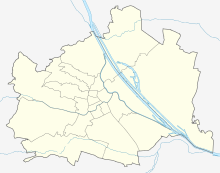Bridge over the main avenue
Coordinates: 48 ° 11 ′ 38.2 " N , 16 ° 26 ′ 10.5" E
The bridge over the Hauptallee is a bridge of the Ostbahn in the 2nd district of Vienna , Leopoldstadt , which leads over the Hauptallee in the Vienna Prater .
history
The route of the elevated railway line from Vienna towards Moravia and Hungary (now Slovakia ) built by the Austrian State Railroad Company , which was privileged by the kk , made it necessary to bridge the main avenue in the green area of the Prater near the Lusthaus . The railway line crosses the main avenue at an angle of 75 degrees for 16 minutes, because the route is slightly swiveled to the north in relation to the main avenue running from northwest to southeast.
During the construction negotiations on February 13, 1868, a bridge with a central opening of 15 meters and two side openings of 7.6 meters each was prescribed. The clear height had to be at least 5.05 meters. In addition, it was required that the entire steel structure of the building should be made light and pleasing.
It is not known whether the specified dimensions were actually adhered to. Later sources give a width of 13.49 meters for the central opening and 8.43 meters each for the two side openings for the footpaths and bridle paths.
The official specification of the clear height of the bridge and the height of the dam crest made a beam construction made of half-timbered with two additional supports necessary. The cast iron supporting pillars were arranged in a total of six groups of four in line with the trees in the main avenue and each carry the three continuous parallel lattice girders of the bridge. In addition, the middle supporting wall was reinforced accordingly.
In order to achieve the required pleasing shape, the supporting structure was then clad with zinc sheet, to which pressed and cast zinc ornaments were soldered and screwed. After priming with zinc gray, there was a final coating with silver bronze. This cladding gave the bridge the appearance of a segmented arch bridge with a richly decorated parapet. The interplay of shape and color gave the impression of a stone bridge.
The plans for the bridge construction come from the engineers Rogenhofer and C. v. Ruppert jun., While August Köstlin was responsible for the architectural part.
In 1898, the bridge over the main avenue was widened by adding two more girders to make space for a central platform. It is not known when the bridge got its current shape.
From 1883 until the beginning of the Second World War, the bridge was on the route of the Orient Express from Paris to Istanbul , which at that time covered the section Vienna – Budapest via Pressburg on the north, left bank of the Danube.
Participating companies
- Stach and Braun Brothers ( Vienna ): Manufacture of the abutments and pillar bases
- Johann Caspar Harkort ( Duisburg ): Manufacture and assembly of the bridge structure and the sheet metal girders over the columns and the framework for the zinc cladding
- Princely Salm'sches Eisenwerk ( Blansko ): Casting of the columns, architraves and candelabra
- Carl Diener (Vienna): zinc cladding, ornaments, vases and so on.
present
Today, the bridge is used by trains departing from Vienna Central Station in the direction of Laa an der Thaya (northern branch) and Marchegg ( eastern branch ), as well as long-distance trains of the northern railway towards Brno , Prague , Berlin , Krakow and Warsaw . Via Marchegg you drive to the nearby Slovak capital Pressburg . There are also trains on the S 80 S-Bahn between Vienna Aspern Nord and Vienna Hütteldorf or Unter Purkerdorf.
literature
- Journal of the Austrian Association of Engineers and Architects , Vienna, 1871
- Vienna at the beginning of the XX. Century - A guide in the technical and artistic direction , published by the Austrian Association of Architects, Verlag von Gerlach & Wiedling, Vienna, 1903
- Technical guide through Vienna , published by the Austrian Association of Engineers and Architects, edited by Ing. Martin Paul (urban planning inspector), Vienna, published by Gerlach & Wiedling, 1910
- Alfred Pauser: " Bridges in Vienna - A guide through building history ", Springer Verlag, Vienna 2005, ISBN 3-211-25255-X



